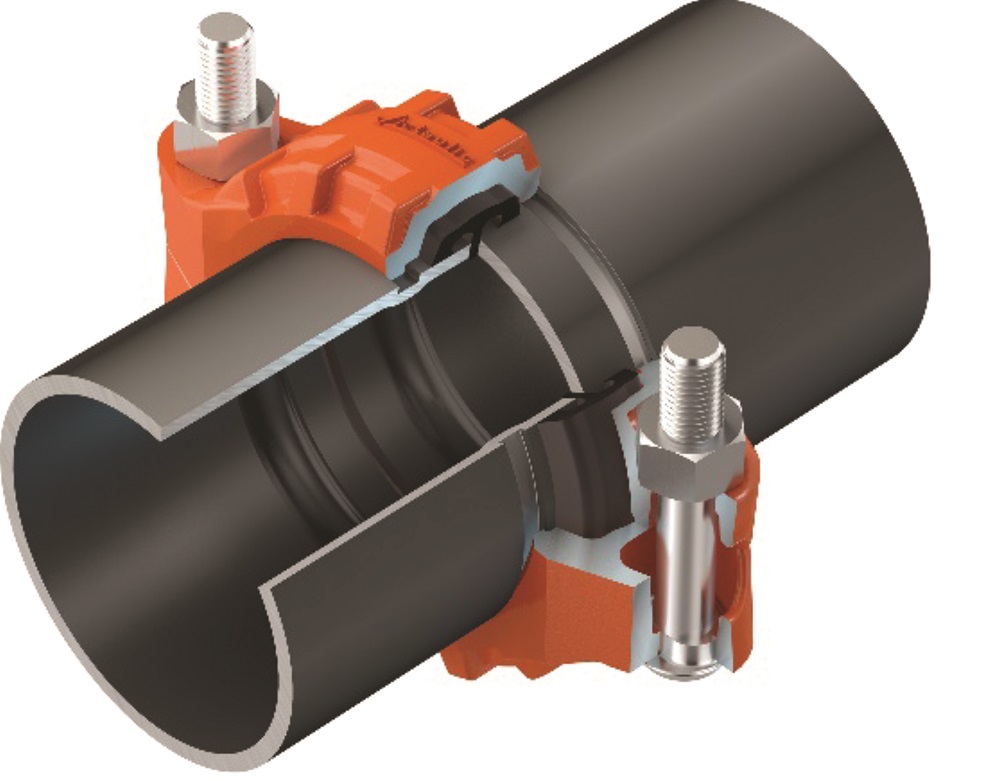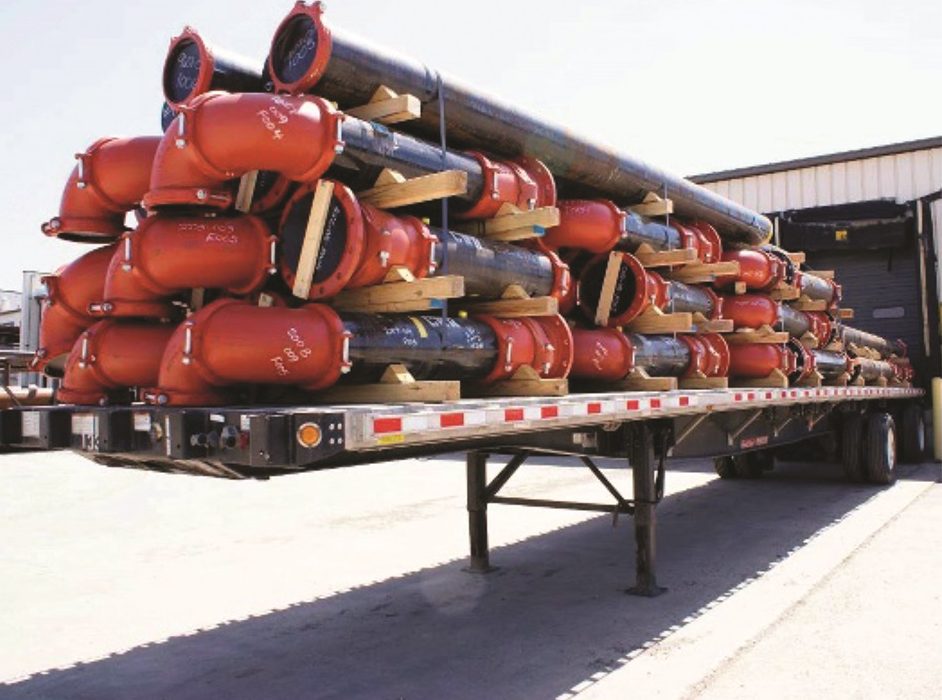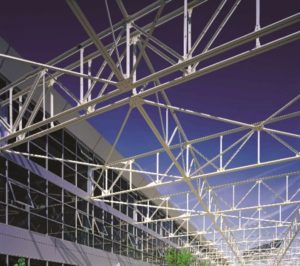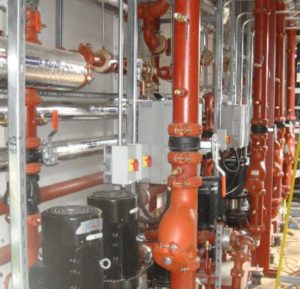Underscoring that sustainable design involves more than site orientation and energy-saving construction techniques, Stephen Traynor enumerates the advantages of grooved mechanical piping systems, and highlights how alternative joining methods could contribute towards higher building rating.

Mechanical grooved piping systems significantly reduce or eliminate waste, emissions and noise pollution during installation.
Population growth and subsequent development has had a major impact on our natural environment, and the effects of pollution have become more obvious than ever in recent decades. This has sparked a movement to promote energy efficiency and a real need to establish organisations that promote a Green and sustainable future.
With the construction industry being one of the larger consumers of energy and resources, the manufacture, design, construction and operation of buildings has never been more critical than it is today.
Cradle to grave
Sustainable design involves more than just site orientation and energy-saving construction techniques. What goes into a building in the way of infrastructure is equally important. Well-planned HVAC, plumbing and other mechanical engineering systems are key to making a building sustainable throughout its lifecycle.
This philosophy needs to be taken into account from the point of manufacture, for instance, employing lean production processes to reduce waste and increase efficiency, manufacturing with recycled materials, dip coating to minimise Volatile Organic Compounds (VOCs), and reusing sand.
Accurate prefabrication also reduces the need to over-order product for site assembly
Choosing to use a tried and tested alternative technology can also make an impact. The case-in-point is grooved joining technology, which is rooted in sustainability, and even before the evolution towards Green Building gained visibility, was providing a more efficient, cleaner and safer system when compared with other pipe joining methods, such as welding, soldering or brazing.
Grooved systems employ a proven roll grooving process to join pipes, valves and other components. Using a two-bolt coupling design, pipe fitters can make rugged, secure joints quickly and easily using only basic hand tools. And with a union at every joint, contractors have maximum field flexibility for on-site decision-making. All couplings are sealed for optimum integrity with a durable elastomeric gasket designed to withstand years of sustained high compressive and cyclical loads.
[div class=”text-box text-box-left” style=”background-color: #0f4000; color: #FFFFFF; “]

Grooved prefabrication minimises transportation costs and site impact.

The LEED Platinum-rated Alberici Headquarters in the United States benefited from the innovative design flexibility of grooved mechanical pipe joining.

Installing a mechanical grooved piping system in London´s Hackney Borough Council Customer Service Center reduced the total system weight and enhanced on-site material handling.

The Tetra Pak facility in Pune, India, was awarded Platinum Certification by the Indian Green Building Council (IGBC).
[end-div]
During installation, mechanical grooved piping systems significantly reduce or eliminate waste, emissions and noise pollution on the jobsite, providing a safer and healthier environment. By-products of welding fumes can contain lead oxide, carbon monoxide, VOCs and hydrochloric acid, in addition to many other harmful particles and gases. The elimination of these harmful pollutants not only means less airborne pollution, providing for a more sustainable environment but also a safer jobsite during construction, maintenance or retrofit work.
Additionally, a grooved mechanical pipe joint does not require the use of electricity during installation, reducing the draw on burdened power resources. Pipes that are joined by welding or soldering require the use of vast amounts of electricity for prolonged periods of time, consuming up to 4 kW on a 200 mm (DN200) joint.
The installation of a grooved mechanical joint is cleaner than soldered joints, and so reduces on-site job waste. Unlike soldering and brazing methods, grooved mechanical joints do not require flux to seal the joint, which must be flushed and cleaned from the system prior to operation. Additionally, soldered systems may require as much as 35% re-work for failures. Grooved mechanical pipe joints can be visually inspected for proper installation so re-work is minimal, saving energy, resources and time on the job, while being generally easier to align and rotate.
Advantages of prefabrication
Piping is an area where front-loading efficiencies and maximising productivity can produce significant savings in man-hours, and ultimately help compress construction schedules and reduce environmental impact.
In fact, while piping system materials can account for as little as one per cent of total installed costs on a project, their installation time can eat nearly 30% of the entire project schedule. Therefore, when considering the significant schedule and cost advantages, as well as optimised energy consumption achieved by strategic prefabrication, one can begin to see why prefabrication is, indeed, coming of age.
Fabrication shops provide a cleaner, more organised environment, where tooling and efficient layouts allow pipe spools to be manoeuvred more safely and more quickly than on the jobsite, resulting in less material waste and optimised energy use. Accurate prefabrication also reduces the need to over-order product for site assembly, leading to reduced lay down area and minimising overall site impact.
Grooved prefabrication also minimises transportation costs. Joined pipe can be prefabricated and configured to lay flat on a truck bed, unlike prefabricated welded spools. This means that two-thirds more material is transported per truckload as compared to welded pipe spools.
Whole life benefits
Energy costs typically represent 30% of a building’s annual budget, and are the single largest operating cost (Energy Star). The Energy Systems Lab at Texas A&M University has indicated that energy use in buildings could be reduced from 10 to 40% by improving operational strategies in buildings, including maintenance strategies.
During installation, mechanical grooved piping systems significantly reduce or eliminate waste, emissions and noise pollution on the jobsite, providing a safer and healthier environment
The grooved piping system is effective on a variety of piping systems, including the promotion of lighter wall pipe on a variety of applications. Lighter wall pipe can provide 5 to 10% more cross-sectional flows than welded pipe. Pipe couplings and fittings are designed to minimise friction, improve throughput and, thus, reduce power requirements at the pump.
Additionally, with soldered or brazed piping systems, accessing valves, strainers, pumps and water softeners is often a time-consuming and inconvenient process due to necessary system shutdown and drainage. In practice, the more difficult the process, the more likely the maintenance will be deferred. For access to a grooved piping system, a maintenance person simply loosens the two coupling bolts.
A lot of buildings also suffer from temperature variations that can lead to tenant complaints, high energy consumption and increased operating expenses. In most cases, these faults can be easily resolved by installing grooved balancing valves in the heating or cooling system in conformance with original design performance specifications.
Grooved contribution
[div class=”text-box text-box-right” style=”background-color: #0f4000; color: #FFFFFF; “]
The Stockholm Waterfront development is Sweden’s largest Green project, in the city designated the first-ever ‘European Green Capital’. The 11-storey structure occupies around 100,000 square metres and comprises a 3,000-capacity congress hall, a 418-room hotel and a 23,300 m² business complex. Sustainability was a key criterion for the development, particularly in the use of energy-efficient systems for heating and cooling, and it achieved a LEED Gold certification.
The glass façades collect solar power, gathering on average 1 MW of heat energy each day. The buildings are cooled by fresh water drawn from nearby Lake Klara, stored in ice tanks in the basement. About 20,000 m² of material has been reused from the building previously occupying the site.
At the heart of the Waterfront development is a large integrated mechanical room, which serves each building, allowing heat and cooling to be deployed to individual buildings as required, and controlled by each building. Contractors working on the HVAC system chose the project to pilot the use of grooved-end mechanical pipe joining – the first time this method had been used in a mechanical room in Sweden. It helped get the job done on time and on budget, and convinced the contractor to use grooved technology more extensively in the future.
Whilst the prefabrication of welded sections was completed off-site, pipework was assembled on-site using the grooved method. And because welding was not used on the site, the installation met the project’s Green criteria. Grooved-end pipe joining causes zero emissions, so workers and the atmosphere were not exposed to toxic fumes, and no electrical energy was used in the joining process.
[end-div]
In order to promote sustainability through the life of a building, there are various certification systems all over the world – often called Green or Sustainability Building Councils – with different responses tailored for different regions. These various certification bodies and the criteria they use to classify a building’s energy consumption and level of sustainability vary from region to region, but the goal remains the same.
From Cambodia to Uruguay, and from China to Brazil, grooved piping systems have been installed in numerous LEED-rated buildings, including the LEED Platinum-rated Manitoba Hydra Building in Canada, the LEED Platinum-rated NHN Data Centre in Korea, and the LEED Platinum-rated Alberici Headquarters in the United States.
In Europe, grooved mechanical pipe joining systems were used in the Stockholm Waterfront, one of Sweden’s largest Green projects, which was recently awarded LEED Gold status. Sustainability was a key criterion for the development, particularly in the use of energy-efficient systems for heating and cooling. (For details, see Case study – Stockholm Waterfront.)
Thus, grooved mechanical systems can contribute towards LEED certification, as also BREEAM (Building Research Establishment Environmental Assessment Method) certification.
Grooved mechanical systems can contribute to ratings success with agencies in a variety of ways. Here are just a few of them:
Management of waste and content recycling
Because grooved mechanical pipe joining systems can be produced utilising recycled materials, and the sand for the casting process can be recycled, less construction and demolition debris is disposed of in landfill and incineration facilities, more resources are recovered, recycled and returned to the manufacturing process, and more materials are reused on jobsites. Site waste can also be minimised through lean manufacturing by producing and shipping only required materials, as well as coordinating deliveries according to the contractor strategy and schedule.
Indoor air quality during construction
Unlike welding, which emits highly toxic pollutants, uses vast amounts of electrical energy and speciality gases, mechanical grooved pipe joining systems feature flameless connections and avoid impact on human safety and the environment.
Lowering emissions
Grooved mechanical fittings and couplings can be dip-coated, a process that creates less wasted paint, does not pose hazardous air pollutant (HAP) risks or does not contain as many VOCs as spray processes.
Balancing valves maintain a dynamic flow that enables the HVAC system to provide correct energy output at all times, thus promoting comfort for occupants
Comfort for occupants
Use of a grooved mechanical balancing valve system can enhance overall project ventilation and air distribution flow. Balancing valves maintain a dynamic flow that enables the HVAC system to provide correct energy output at all times, thus promoting comfort for occupants.
Continuous innovation
Manufacturers of grooved pipe joining systems are continuously looking for new opportunities to meet customer demands for innovative, superior green products, such as faster installing environmentally friendly installation-ready couplings, which join pipes without the need to disassemble bolts, nuts and housings.
Conclusions
It is vital that sustainable solutions are considered at every stage in the construction process – from research and development to product manufacturing, system installation and efficient operation through the entire life of a building. Environmentally conscious practices and products positively impact people, the planet and the bottom line of businesses.
Mechanical pipe joining is a highly effective and reliable alternative to traditional pipe joining methods that can deliver sustainability advantages at every stage, throughout the life of a building. Today’s engineering and construction professionals are increasingly focused on constructing buildings that are environmentally sustainable, flexible and energy efficient. The demand for building materials, products and design solutions that factor into creating a sustainable environment has risen dramatically, and adopting a tried and trusted alternative pipe joining method can be a sound way of contributing to sustainability goals.
CPI Industry accepts no liability for the views or opinions expressed in this column, or for the consequences of any actions taken on the basis of the information provided here.
Stephen Traynor is Victaulic Division Manager Middle East, Africa and India. He can be contacted at stephen.traynor@victaulic.com.
Copyright © 2006-2025 - CPI Industry. All rights reserved.